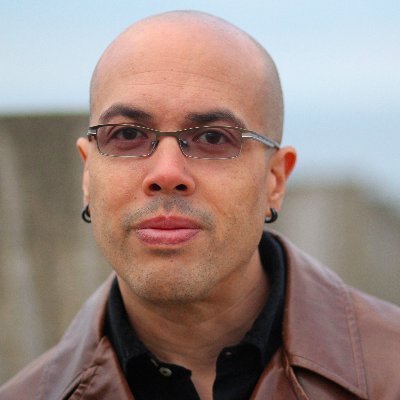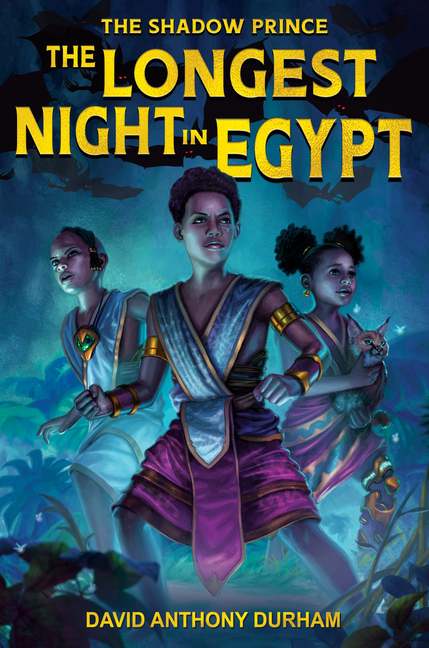From Teaching to Writing

TeachingBooks asks each author or illustrator to reflect on their journey from teaching to writing. Enjoy the following from David Anthony Durham.
A Spark of Inspiration
by David Anthony Durham
Of the nine published novels that I’ve written there’s only one for which I remember exactly when, where, and why the inspiration for it struck me. The book is The Shadow Prince (Lee & Low, 2021), the first novel in my middle grade solar-punk fantasy series. It was because of my kids and the way we were educating them that it came together so effortlessly.
Here’s the setting of that fateful day. A hot summer afternoon. I had just mowed the grass and came inside to sit down and have a drink of water. I noticed a paperback book about ancient Egyptian gods on the coffee table. My son and daughter had borrowed it from a neighbor, a professor with a focus on Egypt. I began flipping through it. I was immediately thinking about how to build on the interest that spurred them to bring this book home.
We were homeschooling our elementary-age kids at the time. As soon as we took the leap to try homeschooling everything became inspiration for learning. Kids are so naturally curious, and we realized that each and every day provided opportunities to explore and learn about the world with them. Questions asked and expressions of interest in things that would’ve come and gone unnoticed previously now flagged themselves as teachable moments. That might sound grim for the kids. Who needs everything to be a teachable moment? But we knew our approach to teaching was effective when it combined education and entertainment—and interests they naturally expressed.
Because of their interests my interests took on a new perspective too. I hadn’t seriously considered writing for kids at that point, but I had thought a lot about ancient Egypt. I was fascinated by its history and mythology in college, and I had attempted an adult novel set in ancient Egypt. I wrote a hundred pages of it before sharing it with my editor at the time. He found it interesting but “too foreign.” To me that was a virtue! I felt deeply connected with imagining myself into an ancient mindset, into seeing value and logic in beliefs that I don’t have within my modern worldview. My editor was not convinced, and I had to move on to other projects.
But on that summer day with the small, borrowed volume on Egyptian mythology – and thinking of my kids – my fictional mind moved in a different direction. Instead of “too foreign” I looked to fun, whimsical, accessible, to a version of ancient Egypt that felt modern—and even futuristic.
My main character—Ash—became my narrative entry point for this. He spoke with the voice of a twelve-year-old, with touches of humor and snark, but also emotion and vulnerability. He was the kind of friend I thought my kids would like. The story he told was of a poor kid growing up with a mentor in a village far out in the desert, far away from the magical workings that powered the Egypt he was on the fringes of. He’s had a strange education that he can’t make much sense of, and – while he’s not technically an orphan – who, what, and where his parents are is a mystery to him.
It’s not long before Ash is drawn into the center of things, summoned to the capital to compete with other youths to become a guardian and confidante of an Egyptian prince. In many ways he’s introduced to Egypt as eyes and ears for my kids. Through him we meet the gods. Through him beings that had seemed “too foreign” for my editor became out-sized characters with understandable emotions made more complicated by their amazing powers. Instead of distant and unknowable, their traits – powerful, vengeful, generous, benign, wise, petty, courageous, cowardly – skewed toward amusing and even comical spins on the historical record. There’s plenty of ways they embody the mythology—in that regard they’re teachable—but they do so at a level and tone intended to engage and entertain.
Being fantasy the story needed magic—and an explanation for how magic works. This also clicked into place like…well, like magic. The gods themselves are innately magical, each with their own abilities and responsibilities in keeping the world functioning and in service to humanity. Lord Ra takes that even further. In his daily journey across the sky, he joins his divinity with the power of the sun to shine down a magical solar energy on Egypt. It’s a gift that’s akin to solar power in our world. It powers sunskiffs and sunbarges, sunchariots and sunboards, factories and machinery and magnificent cities that are lit at night by energy stored in beetles and other battery-like devices. It’s a mythological reimagining of renewable energy that’s so close to our reality that it’s hardly even fantasy!
Most importantly, Ra’s magical sunlight powers styluses that magicians use to draw glimmering hieroglyphs that can be sparked into spells! That makes all sorts of wizardly spell casting and fantastical feats possible for humans as well gods—all with an ancient Egypt flavor and a hieroglyphic basis.
The royal family, customs and traditions, aspects of daily life, the gifts of the Nile, the different cities and temples and the roles of different gods: all these things weave through the text and are integral to the perilous adventures the characters face.
Obviously, I didn’t invent this approach to writing for younger audiences, but it filled me with energy and enthusiasm because it all directly fed into the way we were shaping our children’s growth and education. As our kids got older, they transitioned to public middle and high school. They did great there! They stayed just as curious and just as keen on reading and learning about the world in ways that matured as they matured.
And me? I got to embark on a multi-book series that excites the kid in me just as much as it hopefully excites my intended audience. I’ve just signed for the third book in the series. I’m looking forward to seeing what I learn—and can offer to readers—in the next adventure.
Books and Resources

TeachingBooks personalizes connections to books and authors. Enjoy the following on David Anthony Durham and the books he’s created.
- Enjoy this teaching guide for The Shadow Prince
- Discover David Anthony Durham’s page and books on TeachingBooks
- Visit David Anthony Durham on his website, Twitter, Instagram, Facebook, and his GoodReads page.
Explore all of the For Teachers, By Teachers blog posts.
Special thanks to David Anthony Durham and Lee & Low for their support of this post. All text and images are courtesy of David Anthony Durham and Lee & Low and may not be used without expressed written consent.



So inspiring, thank you!